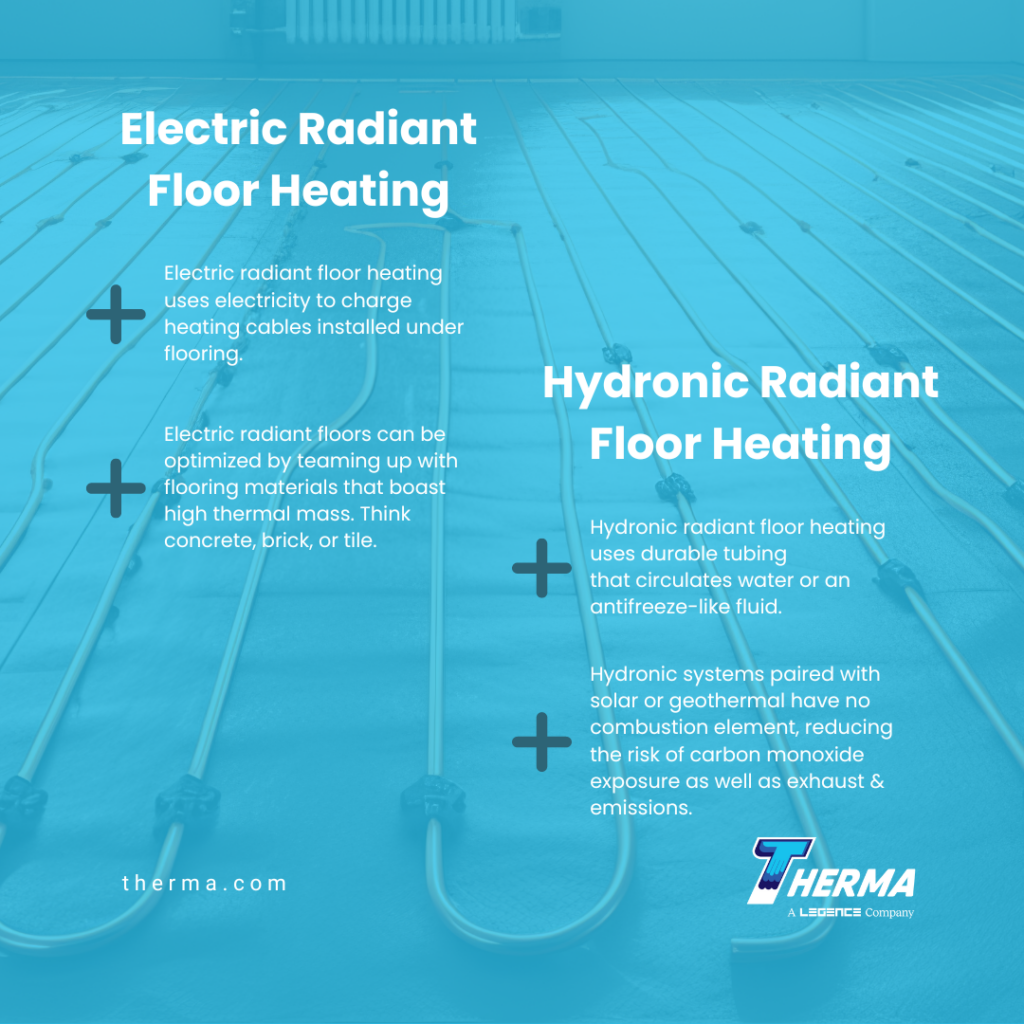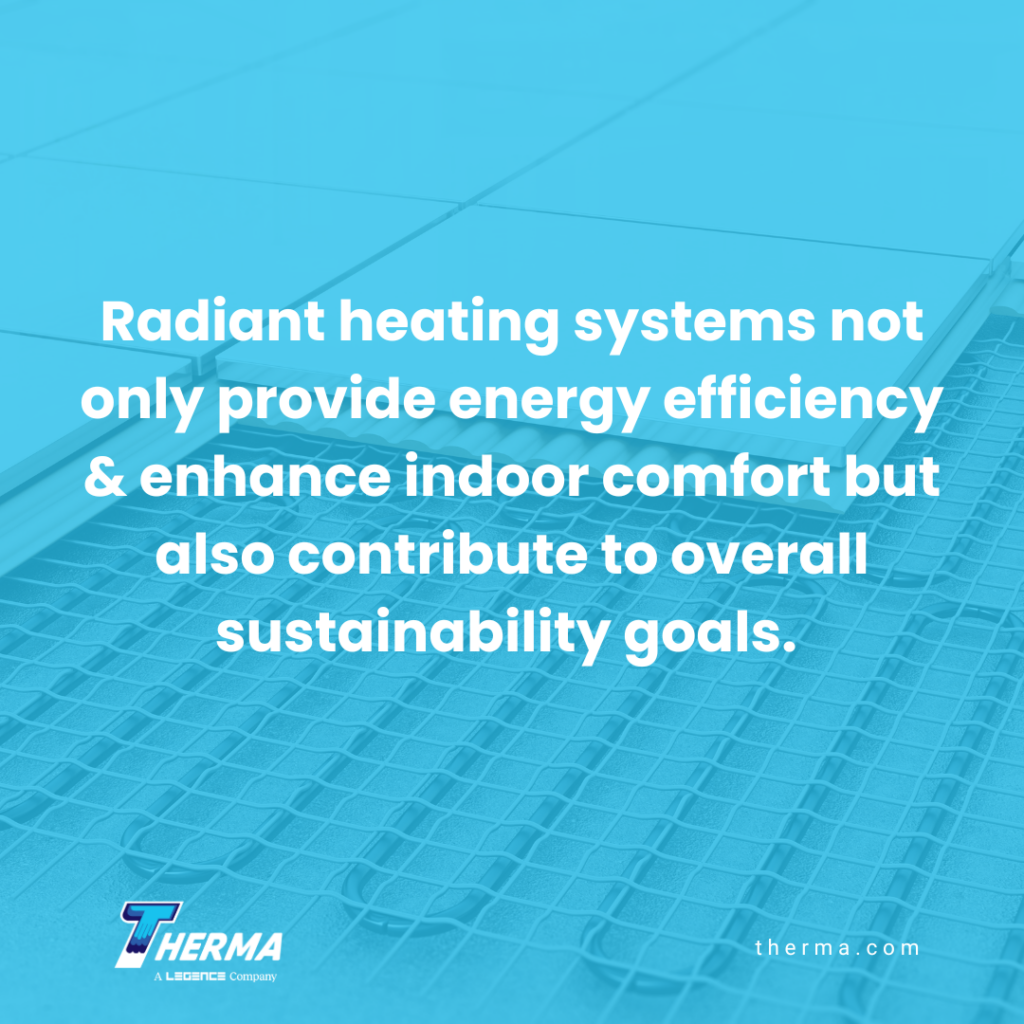by Ali Kriscenski
Radiant heating systems can be energy efficient and help create healthy, comfortable indoor spaces. The benefits of HVAC systems that use radiant floor heating can help contribute to overall sustainability goals and bring long-term energy savings. In this article, we’ll look at how these systems work and how to know if this is a good option for your operational goals.
Radiant Heating
The principle of radiant heating has long been part of heating and cooling strategies. Prior to mechanical HVAC systems, warmed materials such as stone were used to heat spaces. For example, early interior fireplaces were designed to radiate heat into living spaces.
As mechanical systems evolved, the use of ‘radiators’ became an efficient way to distribute heat. These components could be heated by steam or electricity and radiate the thermal energy into rooms through metal heat exchangers.
Today, heating systems can rely on a wide variety of materials, controls, and technologies that have advanced efficiency and integrated application possibilities.
With these advancements, radiant floor heating has become a popular option in homes and commercial settings for its high thermal comfort as well as energy efficiency.
How Radiant Floor Heating Works
There are a few different types of radiant floor systems, and they differ by the type of medium and energy used.

Electric Radiant Floor Heating
Electric radiant floor heating uses electricity to charge heating cables installed under flooring. The cables are controlled by thermostats and can be programmable with the right devices.
These systems can be used to heat add-on spaces, like additions, or small, short occupancy spaces. While electric radiant floors provide thermal comfort, they can have high operating costs.
One strategy to optimize electric radiant floors is to pair this system with flooring materials that have high thermal mass. Materials such as concrete, brick, or tile will absorb the heat from the electric cables and slowly release it over time. By ‘charging’ the thermal mass less energy is required, and less electricity costs.
Hydronic Radiant Floor Heating
Similar to electric radiant floors, hydronic systems can be integrated into flooring applications at the subfloor. Instead of electric cables, hydronic radiant floor heating uses durable tubing that circulates water or an antifreeze-like fluid.
Hydronic systems can be heated with a boiler, water heater, solar, or geothermal. This versatility makes them easily adaptable to existing systems and a major contributor to overall sustainability efforts.
Hydronic systems that are paired with solar or geothermal have no combustion element, reducing the risk of carbon monoxide exposure as well as exhaust and emissions. These factors make hydronic radiant floors with renewable energy an excellent choice for green buildings. They are also cost-effective and can qualify for state or federal energy efficiency incentives, such as rebates or tax credits.
Considerations for Radiant Floor Heating
If a heating system upgrade is part of your capital planning, there are a few considerations to help determine the best option for your facility. Once you assess these factors, you can start to estimate the investment upfront costs, operational expenses, and available incentives that will offset overall costs.
The first criterion to consider is the type of upgrade that the HVAC improvement will be installed. Whether you are planning a renovation, ground-up construction, or an expansion to an existing facility will play a large factor in the type of heating distribution system best suited. If you are building a new facility, the options can be configured to meet a wide variety of heat source and distribution options.
A renovation or expansion may mean that your existing heat source equipment may remain in place. While this might eliminate a new, renewable energy system, it could still allow for electric or hydronic radiant floor heating to be integrated with the existing heat source and fuel type. Staying with a traditional boiler and upgrading to radiant floor heating could still provide energy and cost savings. It may require updated controls to be highly energy efficient, but these costs could qualify for energy efficiency incentives.
Radiant Floor Heating in Your Facility
Depending on your operational goals, radiant floor heating could be a good choice to help you meet them. Navigating the performance, costs, and incentives can become a more robust process by enlisting an experienced HVAC professional who can create an effective strategy. The professionals at Therma can provide the knowledge and resources you need to invest in the most cost-effective and energy-efficient system. If you are interested in learning more about how a radiant floor heating upgrade can benefit your facility, contact Therma today.
AUTHOR BIO
Ali Kriscenski was trained in high-performance building design at Boston Architectural College. She has worked with leading architecture and construction firms in NYC and New England and served on the executive team at the Forest Stewardship Council International. She was the managing editor at Inhabitat and has worked pro bono for the Green Building Institute, ISEAL Alliance, and Habitat for Humanity.
Sources
Building Design + Construction – Passive House Standards Gain in Commercial Building Market
ACEEE – How to Scale Energy Saving Commercial Building Retrofits








